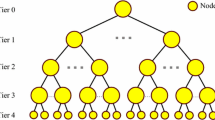Abstract
Data replication is the creation and maintenance of multiple copies of the same data. Replication is used in Data Grid to enhance data availability and fault tolerance. One of the main objectives of replication strategies is reducing response time and bandwidth consumption. In this paper, a dynamic replication strategy that is based on Fast Spread but superior to it in terms of total response time and total bandwidth consumption is proposed. This is achieved by storing only the important replicas on the storage of the node. The main idea of this strategy is using a threshold to determine if the requested replica needs to be copied to the node. The simulation results show that the proposed strategy achieved better performance compared with Fast Spread with Least Recently Used (LRU), and Fast Spread with Least Frequently Used (LFU).
Similar content being viewed by others
References
Cameron DG, Millar AP, Nicholson C, Carvajal-Schiaffino R, Stockinger K, Zini F (2004) Analysis of scheduling and replica optimisation strategies for data grids using OptorSim. J Grid Comput 2(1):57–69
Chang RS, Chang HP (2008) A dynamic data replication strategy using access-weights in data grids. J Supercomput 45(3):277–295. http://dx.doi.org/10.1007/s11227-008-0172-6
Chang RS, Chang HP, Wang YT (2008) A dynamic weighted data replication strategy in data grids. In: AICCSA ’08: proceedings of the 2008 IEEE/ACS international conference on computer systems and applications. IEEE Comput Soc. Washington, pp 414–421. http://dx.doi.org/10.1109/AICCSA.2008.4493567
Cibej U, Slivnik B, Robic B (2005) The complexity of static data replication in data grids. Parallel Comput 31(8):900–912. http://dx.doi.org/10.1016/j.parco.2005.04.010
Dong X, Li J, Wu Z, Zhang D, Xu J (2008) On dynamic replication strategies in data service grids. In: ISORC ’08: proceedings of the 2008 11th IEEE symposium on object oriented real-time distributed computing. IEEE Comp Soc. Washington, pp 155–161. http://dx.doi.org/10.1109/ISORC.2008.66
Figueira S, Trieu T (2008) Data replication and the storage capacity of data grids, Springer. Berlin, Heidelberg, pp 567–575. http://dx.doi.org/10.1007/978-3-540-92859-1_50
Hong L, Xue-dong Q, Xia L, Zhen L, Wen-xing W (2008) Fast cascading replication strategy for data grid. In: CSSE ’08: proceedings of the 2008 international conference on computer science and software engineering. IEEE Comp Soc. Washington, pp 186–189. http://dx.doi.org/10.1109/CSSE.2008.624
Horri A, Sepahvand R, Dastghaibyfard G (2008) A hierarchical scheduling and replication strategy. Int J Comput Sci Netw Secur 8(8) 30–35
O’Neil J, O’Neil P, Weikum G (1993) The LRU-K page replacement algorithm for database disk buffering. In: Proceedings of the 1993 ACM SIGMOD international conference on management of data. ACM, New York, pp 297–306
Ranganathan K, Foster I (2001) Design and evaluation of dynamic replication strategies for a high-performance data grid. In: International conference on computing in high energy and nuclear physics, Beijing, China
Lamehamedi H, Szymanski B, Shentu Z, Deelman E (2002) Data replication strategies in grid environments. In: Proceedings of the fifth international conference on algorithms and architectures for parallel processing, pp 378–383
Park S, Kim J, Ko Y, Yoon W (2003) Dynamic data grid replication strategy based on Internet hierarchy. In: Second international workshop on grid and cooperative computing, pp 838–846
Ranganathan K, Foster I (2001) Identifying dynamic replication strategies for a high-performance data grid. In: GRID ’01: proceedings of the second international workshop on grid computing. Springer, London, pp 75–86
Rasool Q, Li J, Oreku GS, Munir EU (2008) Fair-share replication in data grid. Inf Technol J 7(5):776–782
Tang M, Lee BS, Yeo CK, Tang X (2005) Dynamic replication algorithms for the multi-tier data grid. Future Gener Comput Syst 21(5):775–790. doi: 10.1016/j.future.2004.08.001
Prischepa V (2004) An efficient web caching algorithm based on LFU-K replacement policy. In: Proceedings of the spring young researcher’s colloquium on database and information systems. IEEE, New York, pp 23–26
Wu JJ, Lin YF, Liu P (2008) Optimal replica placement in hierarchical data grids with locality assurance. J Parallel Distrib Comput 68(12):1517–1538. http://dx.doi.org/10.1016/j.jpdc.2008.08.002
Zhao W, Xu X, Xiong N, Wang Z (2008) A weight-based dynamic replica replacement strategy in data grids. In: APSCC ’08: proceedings of the 2008 ieee asia-pacific services computing conference. IEEE Comput Soc. Washington, pp 1544–1549. http://dx.doi.org/10.1109/APSCC.2008.41
Author information
Authors and Affiliations
Corresponding author
Rights and permissions
About this article
Cite this article
Bsoul, M., Al-Khasawneh, A., Kilani, Y. et al. A threshold-based dynamic data replication strategy. J Supercomput 60, 301–310 (2012). https://doi.org/10.1007/s11227-010-0466-3
Published:
Issue Date:
DOI: https://doi.org/10.1007/s11227-010-0466-3




